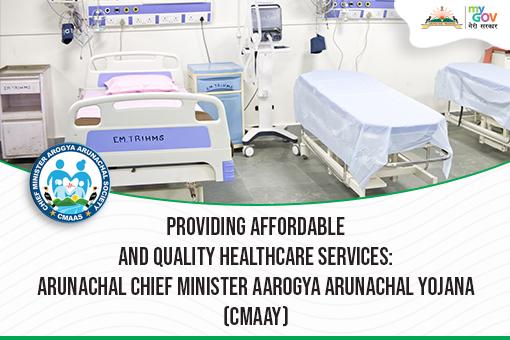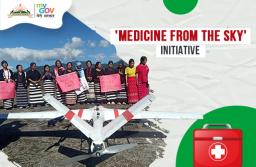Since its inception, the Chief Minister Arogya Arunachal Yojana, abbreviated as CMAAY, has been a great help to the citizens of Arunachal Pradesh. Launched on August 15th, 2018, this state government flagship program under the Department of Health and Family Welfare aims to deliver high-quality healthcare services to the indigenous people of the state, as well as the government employees by providing financial aid during major illness and hospitalization in the empanelled hospitals (across the country.)
CMAAY's main goal is to lessen the financial impact that medical conditions and hospital stays have on our citizens, the program guarantees that patients won't have to worry about the expenses of costly medical procedures out of their own pockets by offering cashless healthcare services. The program also focuses is ensuring that all lawful state residents have fair access to high-quality healthcare. This implies that everyone has a right to receive the same quality of healthcare treatments, irrespective of their social standing or financial situation. In terms of getting medical care, this guarantees that no one is left behind; fostering equality.
Furthermore, CMAAY has a big impact on improving the public health system's efficacy, efficiency, and self-reliance. The initiative aids the financial aspects of medical services by guaranteeing that claim refunds are immediately credited into the respective government hospital accounts. This transparency promotes more effective resource management, which eventually results in better healthcare services for everybody.
Last but not least, another objective of CMAAY is to close the gap between the state's secondary and tertiary healthcare systems. This means that people now have access to specialized medical services and treatments that had been previously inaccessible or limited. This initiative guarantees that those with critical medical illnesses receive the treatment they require by offering complete health care coverage.
The Chief Minister Arogya Arunachal Yojana has had a positive impact on the local citizens of Arunachal Pradesh who have applied and received the benefits under the scheme. Many testimony suggests that it has immensely reduced the financial burden on individuals during hospitalization, with access to inexpensive medicine (you can get it from PMAAY pharmacies) and high-quality medical services. It has indeed ensured equitable access to quality healthcare and made the public health system more efficient as well as bridged the gap in secondary and tertiary healthcare services. To avail the benefits of CMAAY, go to www.cmaay.com or download the app Arogya Arunachal, and follow the instructions for further process.
We invite citizens to discuss their experience with the CMAAY program. Tell us what you think the Government should do to make the healthcare system in the state better and affordable for all. Let's work together to make sure everyone gets exemplary medical care













BrahmDevYadav 1 year 4 months ago
What are the eight leading health indicators?
1.Access to Health Services.
2.Clinical Preventive Services.
3.Environmental Quality.
4.Maternal Infant and Child Health.
5.Mental Health.
6.Nutrition, Physical Activity and Obesity.
7.Oral Health.
8.Reproductive and Sexual Health.
BrahmDevYadav 1 year 4 months ago
Which state in India is best in healthcare?
Government think that Niti Aayog released the fourth edition of its health index, which ranked states based on overall health performance. Kerala was ranked as the best performer on top, while Uttar Pradesh was the worst.
BrahmDevYadav 1 year 4 months ago
What is the difference between standard of care and usual care?
A standard of care differs from usual care in that usual care is directed by medical orders and varies in its implementation from clinician to clinician.
BrahmDevYadav 1 year 4 months ago
What is enhanced usual care?
In an enhanced usual care condition, usual care is systematically improved by the research protocol to overcome ethical or methodological problems that would accompany ordinary UC.
BrahmDevYadav 1 year 4 months ago
What are the standards of good clinical practice?
A standard for the design, conduct, performance, monitoring, auditing, recording, analyses, and reporting of clinical trials that provides assurance that the data and reported results are credible and accurate and that the rights, integrity and confidentiality of trial subjects is protected.
BrahmDevYadav 1 year 4 months ago
What is best standard of care?
A standard of care or best practice is a guideline for the appropriate treatment of a condition as established by formal or informal consensus among experts on that condition. Basically, the standard of care for the treatment of a disease is whatever most physicians agree is the best way to treat that disease.
BrahmDevYadav 1 year 4 months ago
What are the five dimensions of patient-centered care?
The IOM endorsed six dimensions of patient-centered care which stated that care must be on the following:-
1) Respectful to patients' values, preferences and expressed needs.
2) Coordinated and integrated.
3) Provide information, communication, and education.
4) Ensure physical comfort.
5) provide emotional support to the patient.
BrahmDevYadav 1 year 4 months ago
How do we ensure that high standard of care is delivered?
1. Patient Safety:- Quality standards promote practices prioritising patient safety and
minimising the risk of medical errors, infections and other preventable harms.
2. Enhanced Patient Outcomes: Adhering to quality standards improves patient outcomes by
ensuring consistent, evidence-based care that follows best practices.
BrahmDevYadav 1 year 4 months ago
How do we ensure quality control in health care services?
1.Set Quality Standards.
2.Develop Operational Processes That Solve Problems.
3.Review the Outcomes.
4.Utilize Feedback to Gather Valuable Information.
5.Use Data to make Improvements.
6.Make Cleanliness a Top Priority.
7.Post Visible Reminders.
8.Delegate.
BrahmDevYadav 1 year 4 months ago
What is a quality improvement models in healthcare?
Quality improvement is a systematic, formal approach to the analysis of practice performance and efforts to improve performance.